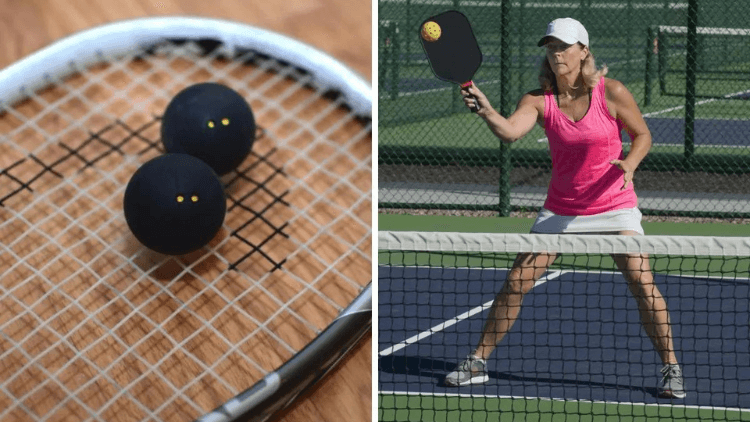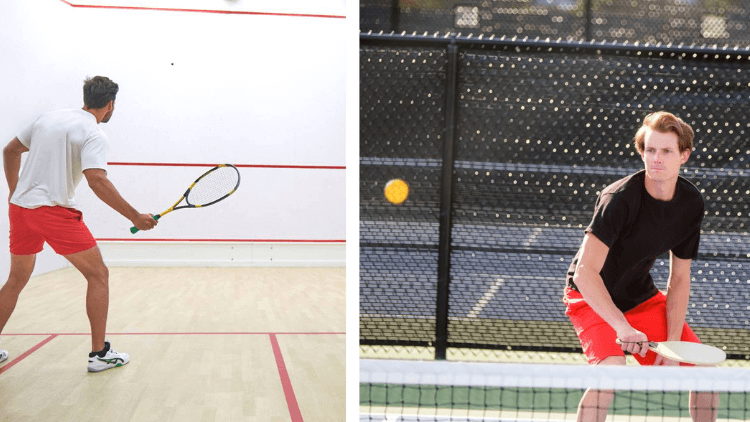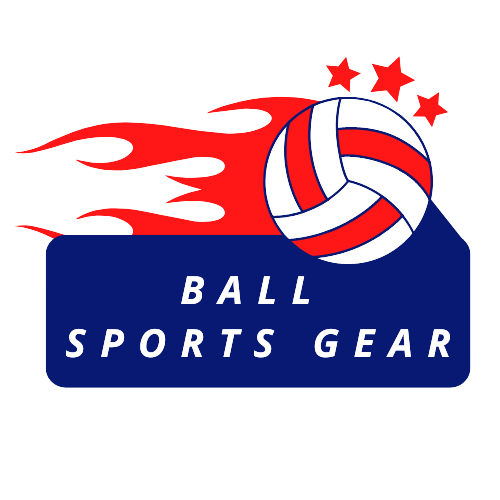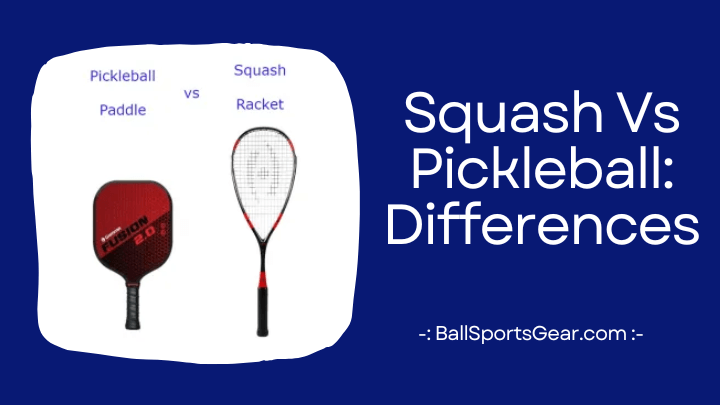Squash and pickleball are both racket sports that involve hitting a ball over a net, but they have many differences in terms of equipment, court size, rules and tactics. In this article, we will compare and contrast these two popular sports squash vs pickleball and give you some tips on how to transition from squash to pickleball.
What’s the Difference Between Squash and Pickleball?
Pickleball Paddle vs. Squash Racquets
One of the most obvious differences between squash vs pickleball is the type of racket or paddle used. Squash racquets have a netted string surface and a long handle, while pickleball paddles are flat and solid, usually made of wood, composite or graphite. Squash racquets allow you to generate more power and spin on the ball, while pickleball paddles limit these aspects. As a result, squash is more about speed and accuracy, while pickleball is more about placement and strategy.
Pickleball vs Squash Balls
Another major difference between squash vs pickleball is the type of ball used. Squash balls are small and rubbery, while pickleball balls are larger and plastic with holes. Squash balls bounce very little and require a lot of force to hit them, while pickleball balls bounce more and fly slower through the air. Squash balls also vary in speed and bounce depending on their color code, while pickleball balls are standardized. Therefore, squash requires more agility and reflexes, while pickleball requires more patience and anticipation.
Pickleball vs Squash Courts
The size and shape of the courts also differ significantly between squash and pickleball. Squash courts are enclosed by four walls, with a front wall that has a service line and an outline, and two side walls that have a service box and a tin (a metal strip at the bottom). The court measures 32 feet long by 21 feet wide, with a diagonal length of 45 feet. Pickleball courts are open-air, with a net that divides the court into two halves. The court measures 20 feet wide by 44 feet long, with a diagonal length of 46 feet. Each half has a non-volley zone (also called the kitchen) that extends 7 feet from the net on both sides. Squash courts are smaller and more confined, while pickleball courts are larger and more spacious.

Pickleball Rules vs. Squash Rules
The rules of the sports also differ heavily. Both are played with a racquet and ball, but that’s where the similarities end. Here are some of the main differences:
- In squash, you can hit the ball off any wall as long as it hits the front wall before bouncing on the floor. In pickleball, you can only hit the ball over the net into your opponent’s half of the court.
- In squash, you serve from one of the two service boxes on either side of the court, alternating after each point. In pickleball, you serve from anywhere behind the baseline on one side of the court, switching sides after each fault until you lose the serve.
- In squash, you can only score a point when you are serving. In pickleball, you can score a point whether you are serving or receiving.
- In squash, you play to 11 points (or 15 in some cases), and you must win by two points. In pickleball, you play to 11 points, and you must win by two points.
- In squash, you can volley (hit the ball before it bounces) anywhere on the court except when returning serve. In pickleball, you can volley anywhere except in the non-volley zone or when returning serve.
- In squash, if your opponent obstructs your shot or swing, you can ask for a let (replay) or a stroke (point). In pickleball, if your opponent interferes with your shot or movement, you can call a fault (point) or a replay.
How to Transition From Squash to Pickleball?
If you are a squash player who wants to try out pickleball or switch to it completely, here are some tips to help you make the transition smoother:
Tip 1: Adjust Your Equipment
The first thing you need to do is get yourself a good pickleball paddle that suits your style and skill level. There are many factors to consider when choosing a paddle, such as weight, size, shape, grip, material and color. You may want to experiment with different paddles until you find one that feels comfortable and gives you enough control and power. You also need to get used to the pickleball ball, which is lighter and slower than the squash ball. You may need to adjust your swing speed and timing to hit the ball effectively.
Tip 2: Change Your Tactics
The second thing you need do is educate yourself on the fundamental pickleball techniques and methods, which differ greatly from squash. For instance, you should become proficient with the drop shot, a soft stroke that lands in the non-volley zone and forces your opponent to advance and smash a low ball. You should also master the dink, a quick shot that barely clears the net while keeping the ball low and near the kitchen. The major methods to score in pickleball are volleys and smashes, thus these strokes are crucial for setting them up. In particular while playing doubles, you need to understand how to position oneself on the court.You want to stay close to your partner and move in sync, covering the angles and gaps. You also want to stay close to the net, but not too close that you get caught in the kitchen.
Tip 3: Learn the Rules
The third thing you need to do is familiarize yourself with the rules of pickleball, which are quite different from squash. You need to know how to serve, score, fault, replay and call lines. You also need to know the etiquette and sportsmanship of pickleball, such as respecting your opponents, partners and referees, avoiding arguments and disputes, and having fun. Pickleball is a social sport that attracts people of all ages and backgrounds, so you want to make friends and enjoy the game.

Frequently Asked Questions
A: Both squash and pickleball require a great deal of skill and athleticism, but some key differences between the two sports can make one more complicated than the other. Squash is more challenging in terms of speed, accuracy and power, as the ball bounces very little and requires a lot of force to hit. Pickleball is more challenging in terms of placement, strategy and patience, as the ball bounces more and flies slower, requiring more anticipation and finesse.
A: Both squash and pickleball provide excellent health benefits, such as improving cardiovascular fitness, stamina, endurance, agility, reflexes and hand-eye coordination. However, squash can be more demanding on the body and cause more injuries due to the high impact and intensity of the game. Pickleball can be more accessible and enjoyable for people of all ages and levels, as it is less strenuous and more social.
A: If you want to switch from squash to pickleball or vice versa, you need to adjust your equipment, tactics and rules accordingly. For example, you need to get used to the different types of paddles or racquets and balls, as well as the different court sizes and shapes. You also need to learn the basic shots and strategies of each sport, such as the drop shot and the dink in pickleball, or the lob and the boast in squash. You also need to familiarize yourself with the rules and etiquette of each sport, such as the scoring system, the serve, the volley and the fault.
Conclusion
Squash and pickleball are both fun and challenging sports that can improve your fitness, coordination and mental skills. They have many differences in terms of equipment, court size, rules and tactics, but they also have some similarities in terms of skills and concepts. If you are a squash player who wants to transition to pickleball, you can use these tips to help you adjust your equipment, tactics and rules. Pickleball is a great sport for all ages and levels, so give it a try and see for yourself!

